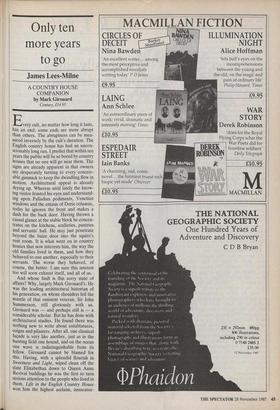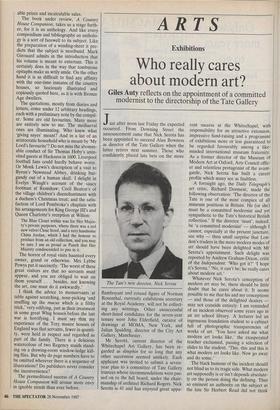Only ten more years to go
James Lees-MiMe
A COUNTRY HOUSE COMPANION by Mark Girouard
Century, £14.95
Every cult, no matter how long it lasts, has an end; some ends are more abrupt than others. The abruptness can be mea- sured inversely by the cult's duration. The English country house has had an uncon- scionably long run. I predict that within ten years the public will be so bored by country houses that no one will go near them. The signs are already apparent in that owners are desperately turning to every conceiv- able gimmick to keep the dwindling flow in motion. Architectural appeal is already drying up. Whereas until lately the know- ing visitor feasted his eyes and understand- ing upon Palladian pediments, Venetian windows and the entasis of Doric columns, today he ignores the front and makes a dash for the back door. Having thrown a casual glance at the stable block he concen- trates on the kitchens, sculleries, pantries and servants' hall. He may just penetrate beyond the baize door into the squire's rent room. It is what went on in country houses that now interests him, the way the old families lived in them, and how they behaved to one another, especially to their servants. The worse they behaved, of course, the better. I am sure this interest too will soon exhaust itself, and all of us.
And whose fault is this sorry state of affairs? Why, largely Mark Girouard's. He was the leading architectural historian of his generation, on whose shoulders fell the mantle of that eminent veteran, Sir John Summerson, still gloriously with us. Girouard was — and perhaps still is — a considerable scholar. But he has done with architectural studies. He found there was nothing new to write about entablatures, coigns and pilasters. After all, one classical facade is very like another, just as in the hunting field one hound, and on the ocean one wave is indistinguishable from its fellow. Girouard cannot be blamed for this. Having, with a splendid flourish in Sweetness and Light, wiped clean off the slate Elizabethan down to Queen Anne Revival buildings he was the first to turn serious attention to the people who lived in them. Life in the English Country House won him the highest acclaim, immeasur- able prizes and incalculable sales.
The book under review, A Country House Companion, takes us a stage furth- er, for it is an anthology. And like every compendium and bibliography an antholo- gy is a sort of farewell to its subject. Like the preparation of a winding-sheet it pre- dicts that the subject is moribund. Mark Girouard admits in the introduction that his volume is meant to entertain. This it certainly does in the way that tombstone epitaphs make us wrily smile. On the other hand it is as difficult to find any affinity with the one-time inmates of the country houses, so lusciously illustrated and copiously quoted here, as it is with Bronze Age dwellers.
The quotations, mostly from diaries and letters, come under 12 arbitrary headings, each with a preliminary note by the compil- er. Some are old favourites. Many more are entirely new to me. The mediaeval ones are illuminating. Who knew what 'giving sayes' meant? And in a list of an aristocratic household who is meant by 'My Lord's favourite'? Do not miss the abomin- able conduct of Sir Thomas Hoby's unin- vited guests at Hackness in 1600. Liverpool football fans could hardly behave worse. Or Monk Lewis's description of a visit to Byron's Newstead Abbey, drinking bur- gundy out of a human skull. I delight in Evelyn Waugh's account of the saucy footman at Renishaw; Cecil Beaton's of the village children's disenchantment with a duchess's Christmas treat; and the satis- faction of Lord Pembroke's chaplain with his arrangements for King George III's and Queen Charlotte's reception at Wilton:
The Blue Closet within was for Her Majes- ty's private purposes, where there was a red new velvet Close Stool, and a very handsome China Jordan, which I had the honour to produce from an old collection, and you may be sure I am as proud as Punch that Her Majesty condescended to piss in it.
The horror of royal visits haunted every owner, grand or otherwise. Mrs Lybbe Powys put it succinctly: 'The worst of these great visitors are that no servants must appear, and you are obliged to wait on them yourself . . . besides, not knowing the art, one must do it awkwardly.'
I think the advice to menservants at table against scratching, nose-picking 'and snuffing up the mucus which is a filthy trick,' very edifying, just as their_treatment in some great Whig houses before the last war is horrifying. I must say—that, my experience of the Tory manor houses of England was that servants, fewer in quanti- ty, were held in respect and regarded as part of the family. There is a delicious watercolour of two Regency maids stand- ing on a drawing-room window-ledge kill- ing flies. But why do page numbers have to be omitted wherever there is a sequence of illustrations? Do publishers never consider the inconvenience?
The premeditated success of A Country House Companion will arouse more envy in ignoble minds than ever before.



































































 Previous page
Previous page